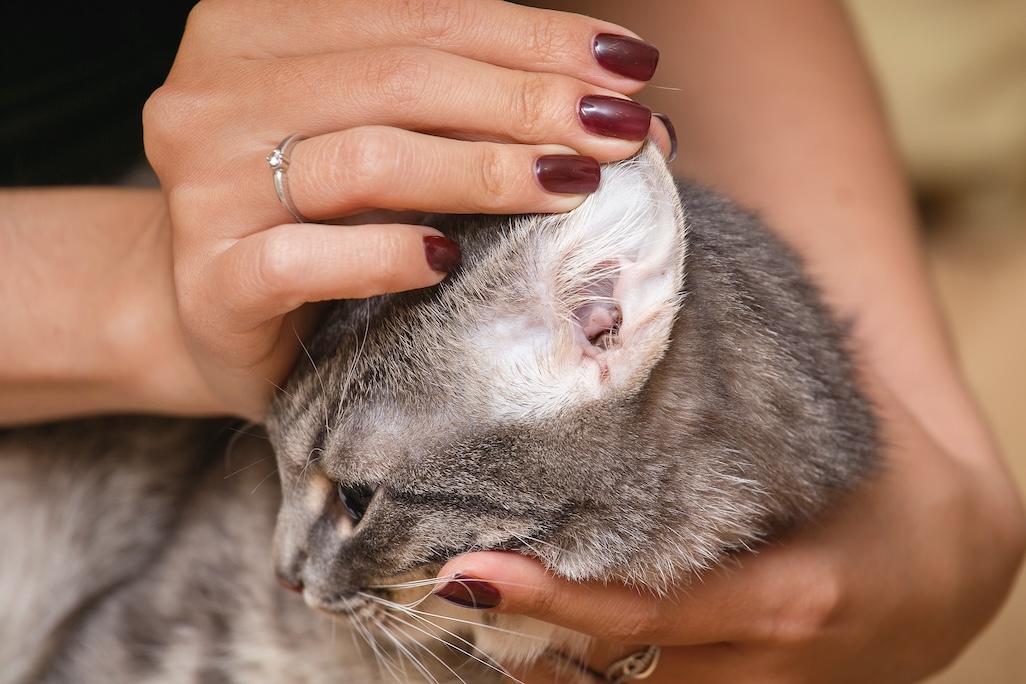How To Deal With A Bad Case Of Ear Mites In Cats
Our cats can be adorable litle weirdos at times, but you're always best off catching on to an infection early - like in the case of ear mites. Here's where to start & what to watch out for.

If you’ve noticed your feline buddy often scratching its ears or shaking its head – you might be dealing with something infectious that’s triggered a bad case of itching. At least one of the reasons could be a case of ear mites in cats, which can cause them a world of misery if you don’t catch it early!
So in this post, here’s everything you need to know about these pesky little critters, including how to spot them, how to get rid of ear mites on cats, and steps you can take to prevent a re-infection. (Plus, how figuring out your cat’s favorite hangout spots can help you spot any mite-prone zones in your neighborhood.)

Find out where your cat spends their time.
Read more- What are ear mites?
- What do ear mites look like in cats?
- Untreated ear mites in cats: What signs to watch out for
- Are ear mites on cats contagious? (Am I in trouble?)
- How to treat ear mites in cats
- What kills ear mites in cats instantly?
- Are there any home remedies to treat ear mites on cats?
- How to check for ear mites in cats (and prevent re-infection)
- How to figure out where your cat is picking up ear mites
What are ear mites?
Ear mites (Otodectes cynotis) are tiny parasites that like to make their homes in animals’ ear canals – including your cat’s. Dogs, sadly, aren’t immune to them either.
These little critters belong to the arachnid genus. Meaning, yes, they’re from the spider family. Cats (and especially kittens) tend to pick up more cases of ear mites than dogs. Ear mites feed on dead skin cells and their bites can severely irritate your poor cat’s ears. In fact, around half of all ear infections in cats tend to be a case of ear mites!
What do ear mites look like in cats?
Ear mites are only about 0.3 to 0.5 millimetres in size. So they’re unlikely to be visible to the naked eye. These parasites can spread in one ear, both ears, or all over your cat’s body.
Ear mites tend to reproduce quickly – laying eggs in your cat’s ears, from where the new mites hatch within days. Because they can spread so quickly, it’s a good idea to keep an eye out for the signs of an infection. So you can take action right away.
Untreated ear mites in cats: What signs to watch out for
When these little parasites burrow into your cat’s ears, their bites and saliva can severely irritate their skin. Here are some of the more obvious signs of a case of ear mites in cats:
- Excessive itching – especially around the ears,
- Shaking their head,
- Black or brown earwax,
- Red, inflamed skin around the ears,
- An unpleasant odor from around your cat’s ears,
- Hair loss – especially around the head and ears,
- Loss of appetite
Left untreated, a case of ear mites in cats can even affect your buddy’s hearing over time. Your cat might not respond when you call out for them or shake their food bowl like usual. Besides, your cat’s ears are actually where their vestibular organs are. Meaning, just like us, the organs that help them keep their sense of balance. A particularly bad ear mite infestation could potentially affect even this – leading your cat to have difficulties balancing itself or getting around!
⚠️ Which is why, if you suspect your cat has a bad case of ear mites, it’s best you drop by your vet for a full checkup.
Are ear mites on cats contagious? (Am I in trouble?)
Yes, ear mites on cats tend to be highly contagious. Your other cats and pets might be at risk for infection. But don’t worry – you’re in the clear! Transmission from cats to humans is extremely unlikely. We just don’t tend to be the best hosts for these little critters. So even if some of your cat’s ear mites transfer to you from a cuddling session, they won’t survive on you for long.
Sadly, your other pets – including other cats, dogs, rabbits, and more – may be at risk. Ear mites can easily transfer from one animal to another through direct, close contact, although they’re more common in cats. Like, for example, from:
- Common playing areas,
- Cuddling together,
- Sleeping together,
- Shared objects, like blankets and brushes
How to treat ear mites in cats
If you notice your cat scratching itself more than usual, get them (and any other pets) to the vet right away. Your vet will begin by inspecting your cat’s ears to rule out the cause of infection. If it’s a bad case, an otoscope can help detect them – or the ear mites might even be visible to the naked eye. Next, your vet will most likely clean out your cat’s ears with a special solution. This makes it easier for the medication to work and is a good health practice for animals in general.
What kills ear mites in cats instantly?
Sadly, there aren’t any products that kill ear mites right away. (Though some can kill them after single use.) Getting rid of them 100% can take months. Your vet will most likely treat a case of ear mites with ear drops or spot-on treatments. You’ll need to apply these regularly for the period of time your vet prescribes, which could be weeks to months. Many flea, tick, and heartworm preventatives also protect against ear mites. Just make sure to get the green light from your vet what’s the best fit for your cat.
Are there any home remedies to treat ear mites on cats?
No, you’re best off following your vet’s advice to a T. You never know what might just end up being toxic to your poor cat and worsen their situation. However, disinfecting your cat’s environment can help get rid of any pesky critters. This includes:
- Regularly washing any blankets, baskets, toys, or other objects your cat spends time around. Hot water can get rid of these little critters right away.
- Likewise, don’t forget any upholstery covers, floors, or carpets your cat has come in contact with while they’re getting treated. A good vacuum can go a long way.
- Use a steam cleaner regularly if you have one available.
- Get all your pets examined by a vet and treated if necessary.
⚠️ Ear mites can survive for a long time outside the host. They thrive in conditions with high humidity and warm temperatures. So they might survive and lurk around your living space for months on end.
How to check for ear mites in cats (and prevent re-infection)
The sooner you pick up on the signs of ear mites in cats – the quicker you can help get rid of them. Here are some steps you can take to prevent a re-infection.
In a calm, familiar environment where your cat feels relaxed:
- Keep your supplies ready, including cotton swabs, a flashlight, or a soft cloth. A magnifying glass can also help.
- Lift your cat’s ear flap and take a peek inside. Your flashlight can help brighten things up a bit.

- Keep an eye out for warning signs like any excessive earwax, crusts, redness, discharge, or inflammation. Dark crumbly earwax that resembles coffee grounds are a tell-tale symptom of a ear mite infestation.
- Gently clean out your cat’s ears with a cotton ball. Avoid going in too deep, or you might injure their ear canal.
How to figure out where your cat is picking up ear mites
Both indoor and outdoor cats can run into ear mites in a whole bunch of places. Specifically, places where they run into other animals – dogs, cats, and more. Including:
- Sleeping areas they share with other pets,
- Any pet play dates where they’re in contact with other dogs or cats,
- Grooming facilities,
- Boarding facilities,
- The animal shelter you adopted them from,
- Interacting with stray or feral cats,
- Running into woodland animals, including rabbits
- Exploring woodland areas with dense vegetation or undergrowth,
- Roaming near any garbage disposal areas
Since ear mites are highly contagious, you’re best off preventing your cat from venturing into any spots where they’re likely to run into other, possibly infected pets and animals. Or, if you’ve got multiple cats at home, your outdoor cats might be bringing home ear mites – which could end up infecting your indoor cats as well.
Where a smart cat collar can help
A GPS and health tracker like Tractive can be an incredibly useful extra set of eyes – or in this case, a preventative monitoring system – for catching subtle signs of discomfort or illness. Including issues like an ear mite infestation. Cats are masters at hiding any signs of sickness. So by the time you notice any severe scratching or discharge, the infestation might be quite advanced. That’s where Tractive’s Health Monitoring can step in.

Now with just a glance at your phone, you can:
- Monitor your cat’s activity.
Ear mites cause irritation, which can make your cat restless or, conversely, so miserable they become sluggish and inactive. With its built-in motion detector, Tractive tracks your cat’s movement throughout the day. If their usual zoomies or active hunting time suddenly drops, it could be an early clue that something is making them feel unwell. - Keep track of your cat’s sleep.
Changes in sleep patterns are another indicator of sickness or discomfort. A cat with itchy, painful ears might have trouble settling down and rest less than usual, or they might try to sleep more because they’re simply run down from the discomfort. Tractive monitors their rest, and if their sleep quality or duration changes, you’ll be able to spot it. - Spot potential health issues early.
Tractive also learns your cat’s normal routine and will send you a Health Alert right to your phone if it detects a significant, unusual change in their activity or sleep. This is a vital early warning system that tells you, “Hey, something’s off,” long before you might notice the signs yourself.
While a smart collar can’t diagnose ear mites (that’s the vet’s job!), it gives you the valuable data you need to know when a vet visit is necessary. So you can catch and treat the issue that much earlier.



